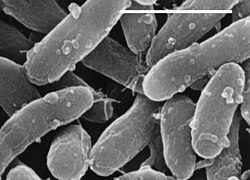| Gemmatimonas | |
|---|---|
 | |
| Scientific classification | |
| Domain: | Bacteria |
| Kingdom: | Pseudomonadati |
| Phylum: | Gemmatimonadota |
| Class: | Gemmatimonadetes |
| Order: | Gemmatimonadales |
| Family: | Gemmatimonadaceae |
| Genus: | Gemmatimonas Zhang et al. 2003 [1] |
| Type species | |
| Gemmatimonas aurantiaca Zhang et al. 2003 | |
| Species | |
| Synonyms | |
Gemmimonas (sic) [2] | |
Gemmatimonas is a Gram-negative, rod-shaped, motile and non-spore-forming genus of bacteria from the family of Gemmatimonaceae. [1] [2] [3]